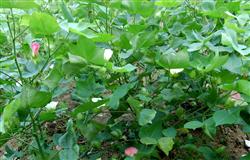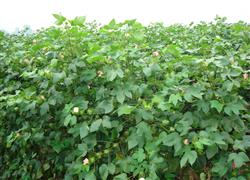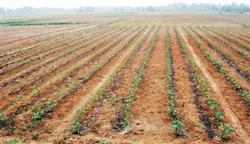Deep-buried drip Irrigation Technology of Cotton

1. General situation of buried drip irrigation 1. The installation site of buried drip irrigation covers an area of 13 hectares and the soil is loam. two。 The installation mode is the buried system modified on the third branch main pipe of the original fourth team five-bucket conventional drip irrigation. The capillary pipe is 1.1 liters per hour and buried below 35 centimeters on the ground. 6 branch pipes are installed on the main pipe and controlled by 6 pressure regulating valves. 3. The sowing method of buried drip irrigation is two-film ten-line machine to pick cotton, the distance between capillaries is 1.52 meters, and one capillary tube has four rows of cotton. Second, the basic situation of the test 1. The experiment was conducted with buried drip irrigation as a treatment, 13 hectares as a treatment, and conventional drip irrigation as a control, 8.3 hectares. two。 The sowing method of buried drip irrigation is two-film ten-row (machine picking cotton), the capillary laying method is buried 35 cm below the surface, one pipe and four arrangements are adopted, the conventional drip irrigation sowing method is two-film ten-row (machine picking cotton), and the capillary laying method is laid on the ground. adopt one pipe and two arrangements. 3. Buried drip irrigation treatment: the date of sowing drip irrigation belt is April 11 ~ 16, and the sowing date of cotton is April 21 ~ 23. The sowing date of cotton treated with conventional drip irrigation was April 21 ~ 23. 4. Cotton variety tested: Xinluzao 10. Third, test results and analysis 1. The change of wetting front of buried drip irrigation treatment is the same as that of conventional drip irrigation loam, which is in the shape of transverse ellipse, except that the position of capillary laying is different. Compared with the infiltration height, the infiltration depth of buried drip irrigation is greater than the infiltration height, and the greater the amount of water is, the deeper the infiltration depth is. Therefore, the one-time drip water volume of buried drip irrigation should not be too large, otherwise deep leakage will be formed. two。 During the whole growth period, the drip time and quantity of drip irrigation of buried drip irrigation and conventional drip irrigation share the same filtration system, dripping water is carried out synchronously from May 25 to August 23. 667 square meters of water is used in the treatment of buried drip irrigation, 182 cubic meters of water is used in the whole growth period of 667 square meters of water in the treatment of conventional drip irrigation, and 88 cubic meters of water is used less than 667 square meters of water in the treatment of conventional drip irrigation. 3. The amount of 667 square meters of capillary in the treatment of buried drip irrigation is 438 meters, and that of 667 square meters in conventional drip irrigation is 920 meters. 482 meters less capillary is used in the treatment of buried drip irrigation than that of 667 square meters in conventional drip irrigation. 52.4% of the capillary is saved. The material cost of the buried drip irrigation treatment is 82.32 yuan, and that of the conventional drip irrigation treatment is 142.09 yuan. The material cost of the buried drip irrigation treatment is 59.77 yuan less than that of the conventional drip irrigation treatment, saving 42%. 4. Effects of two kinds of drip irrigation on growth, development and yield of cotton under the condition that the number of seedlings of 667 square meters was basically the same as that of conventional drip irrigation, the number of bolls per plant and boll weight per plant of buried drip irrigation were 0.2 more and 0.2 grams higher than those of conventional drip irrigation. the per unit yield of seed cotton increased by 15 kg. 5. According to the economic benefit analysis, the output value of the buried drip irrigation treatment is 45 yuan, plus the capillary and accessories save 59.77 yuan, and the water fee is 22 yuan. the total direct economic benefit of the buried drip irrigation treatment is 126.77 yuan more than that of the conventional drip irrigation treatment. 4. Conclusion 1. From the above experimental results, it can be seen that the wetting front shape of buried drip irrigation is the same as that of conventional drip irrigation, and buried drip irrigation is suitable for clayey soil and loam soil, but not suitable for sandy soil. two。 Buried drip irrigation has a remarkable effect of saving water, saving materials and increasing production, so it is worth popularizing in a large area. Fifth, the deficiency of buried drip irrigation and improvement measures 1. Because the sowing and the capillary burying are not carried out at the same time, the capillary and the crop planting line cause dislocation, resulting in uneven crop water and fertilizer and uneven growth. two。 It is easy to bring saline-alkali to the surface when dripping, which has a certain effect on the growth of crops at seedling stage. 3. For one tube and four configuration mode, it is more suitable for machine picking cotton planting, if the capillary laying density is increased, it can be applied to various modes of planting. 4. When sowing drip irrigation belt, buried drip irrigation should be placed in autumn, so that not only does not need to re-prepare the soil in spring, but also does not affect sowing.
- Prev

Foliar topdressing of cotton is necessary in the later stage.
This weather phenomenon of drought before and rain after transplanting is very disadvantageous to the survival and growth of cotton after transplanting, and the growth process is about 10 days later than usual. In order to improve the rate of flower bud formation and boll formation in the later stage of cotton, it is suggested that the majority of cotton farmers should strengthen the management of fertilizer application in the later stage by foliar spraying.
- Next

Technical guidance of Cotton production in Spring in the Cotton area of the Yellow River Basin
Seedling transplanting is light and simple. First, choose a good breeding base. It requires high-rise terrain, leeward to the sun, water and convenient transportation. Second, prepare the materials. The seedling bed was made by using seedling substrate and clean river sand or loaded into a hole plate instead of a nutrition bowl, and the sufficient materials were prepared according to 500 seedlings per square meter seedling bed. Third, timely.
Related
- The first cup of black tea in spring, the flavor and history of tea gardens in Kenya, Africa
- The computer can not only choose potatoes, but also grow tea rice. AI will grow winter oolong tea champion.
- It is not only the inflated tea bitten by insects, but also engraved with the four seasons tea in Beipu.
- The Oriental Beauty Tea Festival in Zhuxian County takes the stage at the weekend to experience the plus-size feast of oil tea.
- & quot; Oriental Beauty Tea & Exploration of Emei in Hsinchu, the hometown of quot;
- The new variety of strawberry "Tainong 1" dessert is the first choice with mellow aroma. Crimson gorgeous
- History of Tea in Taiwan: from Wild Inner Mountain to Export Tea Garden
- Two types of Taiwan Oriental Beauty Black Tea won the British three-Star Award for Childhood Tea Xiang Zhang Jiaqi changed from pilot to champion tea maker.
- Banana species and varieties: the planting history of Taiwan Xianren banana and dwarf banana is long, is banana disease resistant?
- Coffee planting Technology: Qianjie Coffee from Seedling to harvesting

